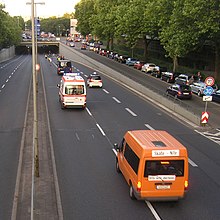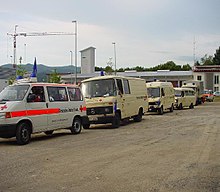Association (road traffic)

A journey in a closed association , in Austria a closed train , is a movement of several road users of an association in public road traffic . In addition to pedestrians and cyclists , who can form associations, motor vehicle travel is the most common form of this traffic. It is also called a convoy , motor vehicle march or Motmarsch .
For closed associations, the uniform traffic rules and regulations that apply to all vehicle traffic apply accordingly. In Germany, § 27 and § 29 of the Road Traffic Regulations and the Administrative Regulations for Road Traffic Regulations regulate the closed associations in road traffic. In Austria, Section 29 of the Road Traffic Act applies . In Switzerland, the Traffic Regulations (VRV, SR 741.11) Articles 43, 49 and 51 apply .
An association is closed if it is clearly recognizable as such to other road users. A column of vehicles is considered to be one vehicle in terms of traffic law . For example, all vehicles in a column are allowed to pass a traffic light intersection even when the traffic light is red, provided that the first vehicle has passed the green light.
Closed associations, funeral procession and processions must, if their length so requires, leave spaces free for other traffic at appropriate intervals; This is not allowed to interrupt them at other points ( Section 27 (2 ) StVO). In Switzerland, funeral procession is usually not overtaken.
Traffic groups
Motor vehicles

Motor vehicle associations represent excessive road use, private or commercial use of the right of convoy always requires the approval of the responsible road traffic authorities .
Associations must firstly be identified in a uniform manner and, secondly, be perceptible as a cohesive unit through their traffic behavior. You will then be treated legally like a single vehicle. In urban areas “the association vehicles must drive tightly unlocked, i. In other words, they can and must maintain such small distances that they just reach or only slightly exceed the safety distances ”. A so-called convoy priority takes effect against all other road users if the leading vehicle was authorized accordingly. This privilege applies to right before left , traffic lights and traffic regulations through traffic signs . From this it follows, among other things, that if the lead vehicle is authorized to enter, all vehicles belonging to the association may pass intersections and junctions, even if an otherwise privileged vehicle appears in the meantime. The interruption of a closed association is not permitted, except in spaces that are specially left for other traffic due to the length of the association ( Section 27 (2 ) StVO).
The road traffic regulations make no statement about what the uniform marking should look like. Large pink buckets that are securely attached to the roof of a number of private cars undoubtedly meet the requirements of the wording of the law, but the road traffic authority can impose labeling requirements as part of the permit.
The authorization requirement does not apply to associations of up to 30 vehicles if this is urgently required to fulfill official tasks (by the fire brigade , police , THW etc.).
For most authorities and organizations with security tasks (disaster control), the police and the Bundeswehr , marching units are identified by square flags attached to the left front of the vehicle. This labeling is based on the NATO agreement STANAG 2154: Regulations for Military Motor Vehicle Movement by Road . A military unit is labeled as follows:
| colour | use |
|---|---|
| Black and white divided diagonally | Union leader who is not firmly in the column |
| blue | First to penultimate vehicle of the association |
| green | Last vehicle in the formation |
| yellow | Defective / damaged vehicle |
| red | Vehicle presenting an increased risk. (For example when towing or if a particularly large amount of fuel is being carried.) |
All vehicles drive - even during the day - with driving lights (low beam). The designation as a closed association is not associated with special rights in all NATO countries: Belgium, Great Britain, Denmark, Turkey and the USA have no special rights for columns. All countries in which the column must not be interrupted impose requirements beyond STANAG 2154.
In Germany, this additional requirement for NATO columns consists of the fact that not only the first vehicle carries the blue flag, but all column participants except the last one (already with a green flag) must show the blue flag. In this way, the international STANAG 2154 and the requirement of the German StVO for uniform labeling are combined. The German additional requirement can be met by means of the normal, always present flag set of every NATO vehicle.
In Italy and Norway, special start and end signs are required instead, Greece also requires a blue or green light at the front and back, and the Netherlands expect everything from a NATO association: Continuous flagging like in Germany, colored lights like in Greece (however on all vehicles), and the first vehicle must fly the blue flag on the right and left.
The Federal Armed Forces regulation resulting from STANAG 2154 and national specifications is also used in Germany by the police, fire brigade and aid organizations - either because an organization-internal regulation requires it (THW), or because a uniform procedure is also considered to be sensible without regulation (municipal fire brigades) .
In order to better warn the rest of the traffic, an association equipped with it may also use a flashing blue light in Germany ( Section 38 (2 ) of the StVO), which increases the attention of other road users, especially when driving following vehicles against a red light. Some fire brigades and aid organizations have tried to use only the lights and no flags at all. In view of the intense impact of modern LED double flash lights on the eyes of the following drivers, this approach is not free of disadvantages over long distances.
A convoy can claim special rights according to § 35 StVO and, if necessary, rights of way according to § 38 StVO, if it is provided by an authority or organization listed in this paragraph and the corresponding necessity or extreme urgency is given. The regulations for associations according to § 27 StVO no longer play a role as soon as the secondary horn is switched on.
The motor vehicle march is intended to ensure that emergency formations with personnel, vehicles and equipment arrive at a specified location at a specified time and can take action. All vehicles together form the marching formation and count as one vehicle, so to speak. They are subject to uniform management and labeling.
Traffic safety is particularly necessary at intersections, road bifurcations, narrow lanes, freeway entrances and at stopping columns. If this is not done by the police, traffic security posts are often used. These inform other road users of the danger, but have no police authority to regulate or issue instructions. Their equipment usually includes a warning vest and trowel .
Although the marching speed of 30 to 70 km / h is relatively low, the total travel time can be reduced through better organization, such as common departure points, route selection and common stopping points with the necessary supplies .
Cyclist
According to § 27 StVO, more than 15 cyclists are allowed to form a closed association. Then they are always allowed to drive side by side on the road in pairs. The Critical Mass form of action makes use of this fact. On routes that are unfavorably built for cyclists, there is an opportunity to ride safely together on the road. In Switzerland there are already 10 cyclists as a group. Driving in a row there is a factual overtaking ban relatively quickly.
pedestrian

Groups of children and young people on foot must use the sidewalks as far as possible. Deviating from the general traffic rules (which only apply mutatis mutandis), action must be taken to ensure that groups marching on foot who want to turn left do not lean into the left lane, but are led to the intersection or junction on the right-hand side of the road.
If necessary, funeral parades and processions must be escorted by the police. Together with the church authorities, it is necessary to examine how the use of busy roads can be restricted.
If necessary ( Section 17, Paragraph 1 of the StVO), the lateral boundary of unions on horseback or marching on foot must be indicated at least to the front by non-dazzling lights with white light, to the rear by lights with red light or yellow flashing light. If such an association is divided into several clearly separated departments, each must be secured in this way. The associations do not need their own lighting if they are otherwise adequately lit. If a unit marching on foot needs its own lighting, it must be ensured that the wingmen of the first and last link also wear lights when a vehicle drives ahead or follows it to protect the unit. Because of the danger of dangerous resonance excitation of the structure, one must not march in lockstep on bridges .
See also
literature
- Claus Christoph Eicher: Attention, column! In: ADAC Motorwelt , issue 11/2015; P. 42
Web links
- Dirk Becherer: Motor vehicle march - a handout for executives and managers in in-house and helper training . German Red Cross , 1999 (PDF; 336 kB).
Individual evidence
- ↑ VRV SR741.11
- ^ Decision of the Berlin Court of Appeal , file number 12 U 190/05, of September 14, 2006 [1] .
- ↑ In an appendix to document FM 55-30 there is a very detailed excerpt from STANAG 2154 on page 153 ff. ( Memento of the original from May 4, 2015 in the Internet Archive ) Info: The archive link was inserted automatically and has not yet been checked. Please check the original and archive link according to the instructions and then remove this notice.
- ↑ National peculiarities are listed in an appendix to STANAG 2154, Differences in National Marking of Columns and Legal Rights , on page 161 ff. Of FM 55-30 ( Memento of the original from May 4, 2015 in the Internet Archive ) Info: Der Archive link was inserted automatically and has not yet been checked. Please check the original and archive link according to the instructions and then remove this notice. can be read.



